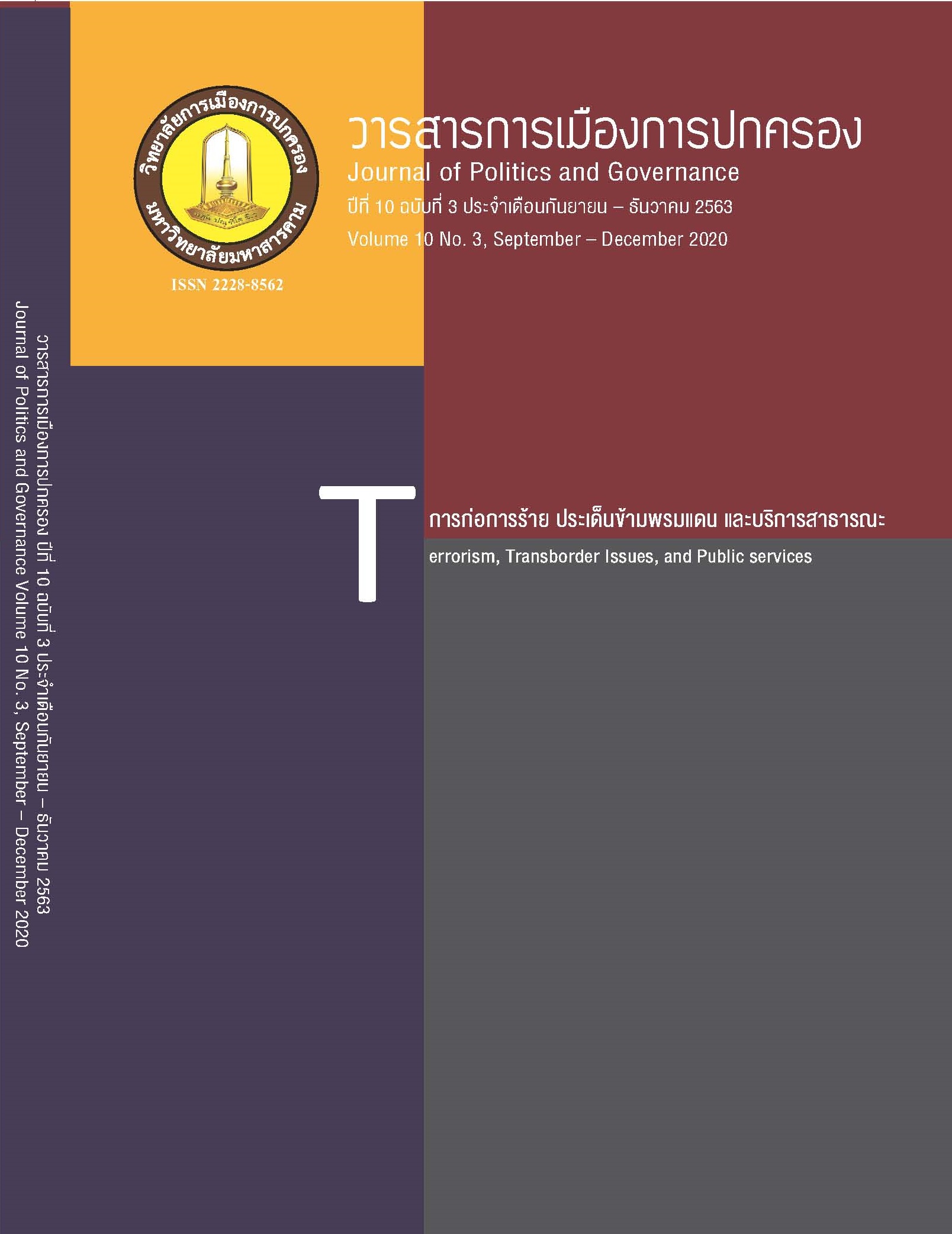The Development of Labour Management Mechanism for Labour Policy Drive in Mukdahan Special Economic Zone
Main Article Content
Abstract
The objectives of this study are as follows: 1) to analyze the requirement of business type to develop the special economic zone in Mukdahan based on all the involving sectors’ suggestions; 2) to investigate the required number of workers and essential skills to develop the special economic zone in Mukdahan which match the business type and true demand in the area; 3) to examine the labouring difficulties which involve the special economic zone in Mukdahan based on reliable information gathered from the studying area; and 4) to synthesize the model for driving the labour policy in the special economic zone in Mukdahan. Qualitative and operational research approaches and reliable information analysis were chosen as the methodology. The study finds that there are five required business types in the special economic zone in Mukdahan which are 1) infrastructure development; 2) logistics; 3) agricultural industry; 4) tourism, wisdom, and culture; and 5) alternative medicine. It needs more than 16,000 workers, and the skills that needs to be developed are technique, industry production, services, tourism, and local medicine. However, there are labouring problems such as 1) information perception and understanding about the special economic zone; 2) the way of life; 3) local labour economic security; 4) local administrative organization adaptation in the special economic zone. The labour policy operation in the special economic zone in Mukdahan is driven by 1) Mukdahan Labour Office, 2) all the involving provincial level sectors in Mukdahan; 3) networking sectors in Muang District, Dontan District, and Wanyai District in Mukdahan. This aims to establish a special center for designing a curriculum and developing the workers’ skills in order to prepare for the border economic expansion based on the area requirement. The relating sectors should create the labour development policy in the special economic zone in Mukdahan which links with economic sustainability. The policy may also focus on the workers’ skill development, life quality, and local capability enhancement in order to improve the labour skills and environment which affect the labour lives.
Article Details
References
สำนักงานแรงงานจังหวัดมุกดาหาร. (2559). สถานการณ์และดัชนีชี้วัดภาวะแรงงานจังหวัดมุกดาหารปี2559. มุกดาหาร: สำนักงานแรงงานจังหวัดมุกดาหาร.
สำนักงานแรงงานจังหวัดมุกดาหาร. (2559). สรุปผลการจัดประชุมสัมมนาและศึกษาดูงานความร่วมมือด้านการค้า การลงทุน การท่องเที่ยว แรงงาน และการประชาสัมพันธ์3จังหวัด/แขวง 3ประเทศ ระหว่าง จังหวัดมุกดาหาร ราชอาณาจักรไทย – แขวงสะหวันนะเขต สาธารณรัฐประชาธิปไตยประชาชนลาว และจังหวัดกวางตรี สาธารณรัฐสังคมนิยมเวียดนาม ภายใต้โครงการส่งเสริมความร่วมมือกับประเทศเพื่อนบ้านในระดับจังหวัด/ท้องถิ่นและกลุ่มประเทศอาเซียน. (รายงานการประชุม). มุกดาหาร : สำนักงานแรงงานจังหวัดมุกดาหาร.
AsianDevelopmentBank. (2016). The Roleof Special Economic ZonesinImproving Effectiveness of GMS Economic Corridors. Retrieved from https://www.adb.org/ sites/default/les/institutionaldocument/214316/role-sez-gms. Pdf.
Ansell, C., and A. Gash. (2007). Collaborative Governance in Theory and Practice.
Journal of Public Administration Research and Theory, 18(4), 543-71.
Baissac, C. (2011). Brief History of SEZs and Overview of Policy Debates. In T. Farole, ed. Special Economic Zonesin Africa : Comparing Performance and Learning from Global Experiences. Washington, DC: The World Bank. Retrieved from http://elibrary.worldbank.org/doi/ pdf/10.1596/978-0-8213-8638-5.
Carter, C., and Harding, A. (2011). SEZs: Policy Incubators or Catalystsfor Development?In Special Economic Zones in Asian Market Economies. New York: Routledge.
Casanova, A. P. D. (2011). Special Economic zones and freeports:Challenges and Opportunities in the Base Conversion and Development Experience in the Philippines, In C. Carter & A. Harding, editors. Special Economic Zones in Asian Market Economies, 108-123. London; New York: Routledge.
Cheesman, A. (2012). Special Economic Zones & Development: Geographyand Linkages in the Indian EOU Scheme from DPU Working Paper No145. London: from The Bartlett/University CollegeLondon. Retrieved from http://www.bartlett.ucl.ac.uk/ dpu/publications/dpu/latest/publications/dpu-workingpapers/WP145.pdf.
Chen, Xiangming and Tomas de Medici. (2010). The ‘Instant City'Coming of Age: Production of Spaces in China's Shenzhen Special Economic Zone. Urban Geography, 31(8), 1141-1147.
Donahue, J. (2004). On CollaBorative Governance. Working Paper No.2. Boston: John F. Kennedy School of Government, Harvard University.
Farole, T., ed. (2011). Special Economic Zones in Africa: Comparing Performance and Learning from Global Experiences. Washington, DC: The World Bank. Retrieved from http://elibrary.worldbank.org/doi/pdf/10.1596/978-0-8213-8638-5.
Farole, T. and G. Akinci, eds. (2011). Special Economic Zone. Farole, T.and G. Akinci, eds. Special Economic Zones Progress, Emerging Challenges, and Future Directions. Washington, DC: The World Bank. Retrieved from. https://openknowledge.worldbank.org/bitstream/handle/10986/2341/638440PUBOExto00Box0361527BOPUBLICO.pdf?sequence=1.


